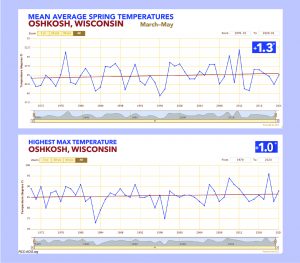Oshkosh spring temps continue to rise
April 28, 2021

Fluctuations between warm and cold weather patterns in Oshkosh this month may be the result of global climate change.
Over the last few weeks, the fluctuation of temperatures has resulted from the rippling effect of a combination of phenomena known as La Niña, the jet stream, and the polar vortex.
According to Beth Johnson, a UWO Fox Cities geology professor, the Midwest is emerging from the effects of La Niña, which is a pattern of Pacific trade winds that push warm water toward Asia and results in cold water along the west coasts of the Americas.
“Complicating this is the fact that the polar vortex circulation pattern was disrupted this year. With climate change, we are seeing that the jet stream is becoming more exaggerated in its path,” Johnson explains. “Parts of it will dip further down into the midlatitudes, which we experience as extreme cold spells in winter.”
As a result of dips in the jet stream, warm masses of air called “sudden stratospheric warmings” travel into polar regions. When springtime occurs, the warm masses of air will dissipate and can result in warm, dry spells, which is what occurred in early April.
“Yes, the 60 degree weather was nice, but it’s not typical for Wisconsin at this time of year,” Johnson said. The unexpected dry conditions have also prompted the Wisconsin DNR to issue burn bans earlier than usual this year.
According to Climate Central, an independent organization of scientists who report research findings on climate change and weather patterns, cities across the United States have been recording higher average spring temperatures for the past several decades.
“In our analysis of 243 cities across the U.S., 120 cities (49%) have recorded an increase in average spring temperatures of 2°F or more over the past 50 years,” Climate Central said. “Further, 96% of cities (234) reported an increase in the number of above-normal spring days since 1970, with 81% of cities (196) reporting an increase of 5 days or more.”
Oshkosh has experienced a 1.3 °F increase in springtime temperatures since 1970, according to RCC-ACIS.org, the Applied Climate Information System.
A one or two degree difference in temperatures can have significant consequences. For instance, the change can lead to an unstable atmosphere, which leads to short- and long-term complications in weather patterns.
“Warmer air can hold more moisture, which will eventually come down as heavier precipitation events. In the wintertime, we would have less snow and fewer days below freezing,” Johnson explained.
The decrease in snow would affect Wisconsin tourism for the winter sports season, as well as impact local ecosystems.
“We are seeing vegetation changes from cold-tolerant species to those that prefer warmer temperatures, as well as an increase in invasive insect species that had previously been kept in check by below-freezing temperatures,” Johnson said.
Those changes aren’t new, but they continue to be an alarming trend. Conservationist, forester, educator and outdoor enthusiast Aldo Leopold, who taught at UW-Madison in the 1930s and 1940s, tracked phonological changes for decades on his property outside Baraboo, which became part of a book, “A Sand County Almanac.” He noted the connections between phenological events such as a plant blooming and a migratory bird arriving, and realized that if the two become out of sync, the bird may starve during a cold snap when flying insects become scarce.













